 Internet of Things (IoT) largely contributes to the Internet technology evolution and its usage. Our world is constantly growing in complexity as well as urban population, that are and become more and more dependent on the Internet. Just to mention a simple example, the IoT will allow a better monitoring of the world safety, limit the loss of natural resources, provide helpful smart objects to users within health or financial services, etc.
Internet of Things (IoT) largely contributes to the Internet technology evolution and its usage. Our world is constantly growing in complexity as well as urban population, that are and become more and more dependent on the Internet. Just to mention a simple example, the IoT will allow a better monitoring of the world safety, limit the loss of natural resources, provide helpful smart objects to users within health or financial services, etc.
Like developed countries, developing countries (DCs) like some African countries should own and control all the processes of such technologies of which we just mentioned advantages above. One of the challenges consists of deploying IoT-based technologies and easing its human usages. The challenges are naturally more significant in DCs due to the weaknesses or the lack of modern infrastructure.
Nevertheless, IoT has some properties that made it a good evolving path. The first is that smart objects are becoming increasingly numerous and varied, they become cheaper as well. The second is the use of wireless communication that allows an easy deployment in a city, building, factory, etc.
Our work in the IoT4D associated team is to create research activities around IoT
Principal Investigators :
Thomas Ndié Djioto, ENSP/University of Yaounde I, Cameroon ;
Emmanuel Nataf, Inria Nancy-Grand Est, Inria associate-team MADYNES
Research objectives :
Foster Internet of Things research in the context of developing countries (DCs)
Scientific achievements :
Implementation of fuzzy logic processing inside the Contiki OS
Publications :
– P.O.Kamgueu, E.Nataf, T.Djotio, O.Festor, « Energy-Based Metric for the Routing Protocol in Low power and lossy network », In proceeding of SENSORNETS, Barcelone, Feb 2013.
– P.O.Kamgueu, E.Nataf, T.Djotio, O.Festor, « Fuzzy-based routing metrics combination for RPL », Doctoral Colloquium SENSORNETS, Lisboa, Jan 2014.
– P.O.Kamgueu, E.Nataf, T.Djotio, « On Design and Deployment of Fuzzy-based Metric for Routing in Low-Power and Lossy Networks », IEEE SenseApp 2015, Clearwater-Beach, USA, Oct 2015.
More about IoT4D: http://www.inria.fr/en/associate-team/iot4d
-
Visit report of Emmanuel Nataf at the University of Yaounde 1, Cameroon – 22 to 30 of August 2016
In the context of the LIRIMA associated team, the Inria team leader Emmanuel Nataf was invited at the University of Yaounde 1 by the team leader Thomas Djotio, from the 22 to 30 of August 2016. During a full week, Emmanuel worked with Patrick Olivier Kamgueu on the first steps towards a real deployment of a backbone network dedicated to connect several wireless sensors networks to the Internet. This collaborating work is defined as a final part of the PhD of Patrick Olivier that started since November 2012. This PhD thesis is co-supervised by Thomas Djotio and Maurice Tchuenté from the University of Yaounde 1,and by Olivier Festor and Emmanuel Nataf from Inria.
Internet of Things in the African context
Internet of Things (IoT) largely contributes to the Internet technology evolution and its usage. Our world is constantly growing in complexity as well as urban population, that are and become more and more dependent on the Internet. Just to mention a simple example, the IoT will allow a better monitoring of the world safety, limit the loss of natural resources, provide helpful smart objects to users within health or financial services, etc.
Like developed countries, developing countries (DCs) like some African countries should own and control all the processes of such technologies of which we just mentioned advantages above. One of the challenges consists of deploying IoT-based technologies and easing its human usages. The challenges are naturally more significant in DCs due to the weaknesses or the lack of modern infrastructure.
Nevertheless, IoT has some properties that made it a good evolving path. The first is that smart objects are becoming increasingly numerous and varied, they become cheaper as well. The second is the use of wireless communication that allows an easy deployment in a city, building, factory, etc.
IoT gateway
Our work in the IoT4D associated team is to create research activities around IoT. During this week we have shared our knowledge on a software prototype that we are jointly developing. This one is a communication gateway between Internet and one or more wireless sensors networks. It allows the monitoring of each network stability from a single web interface. The same interface is also used to create new sensors networks and to gather data that are sent from our sensors (temperature, humidity…). We use cheap hardware which are able to work well in the legacy environment of the ENSP (Ecole Nationale Supérieure Polytechnique) of Yaounde, where we made our deployment tested.
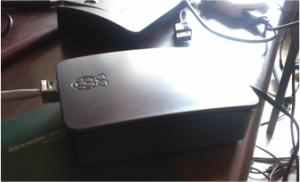
Raspberry Pi for the gateway
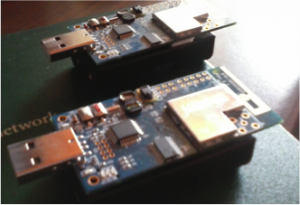
Sky motes for sensors
We extend an existing research software from the CETIC laboratory to develop our IoT framework. Below is a first simple test of a wireless sensor network made of three nodes, connected to the raspberry based gateway through a supplementary node that relays wireless communication.
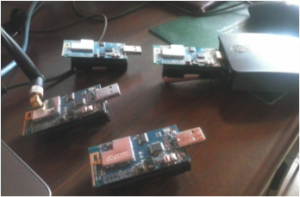
Test deployment
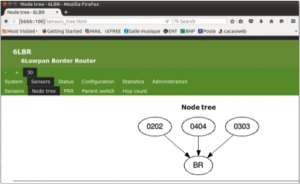
Management GUI
The right part shows the graphical web interface we used to monitor and manage the network. Arrows model the IPv6 routing plane that sensors have established with the standardized RPL routing protocol. Our first step of extension is to allow a single gateway to manage several wireless sensors networks
In the second test, we added three nodes (Z1 and Re-Mote from Zolertia) around the first network. Our management interface was able to separately manage each network, as one can see the second sensors graph on the web interface.
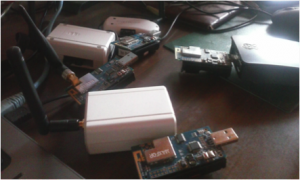
Second test
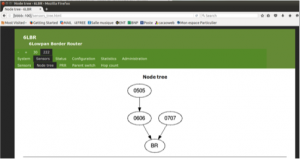
Multiple networks management

